Anatoly Borovkov. Guide to the exhibition "Russian Avant-garde isms. Futurism, Suprematism, Constructivism "
The published text was written by Anatoly Borovkov for printed guide to the exhibition "Russian Avant-garde isms. Futurism, Suprematism, Constructivism, which took place in the CHA from 9 February to 2 March 2011
The published text was written by Anatoly Borovkov for a printed guide to the show « isms Russian avant-garde. Futurism, Suprematism, Constructivism », which took place in the CHA from 9 February to 2 March 2011. The author and organizer of the project emphasizes that this show has done more for themselves than for the visitors: "I really wanted to see at a glance what I have gathered. In general, this exhibition is a kind of model does not exist, unfortunately, in Russia, the Museum of Russian avant-garde. "
The aim of this exhibition from the private collection of objects was to show the main stages of the Russian avant-garde , which has become a weighty chapter in the history of world art. It is mainly about the most important avant-garde directions - Futurism, Suprematism and Constructivism.
Much has been made in our country on the establishment of the museum of Russian avant-garde, but, as the famous fabulist, things are out there . Today the collection of Russian avant-garde can boast only a few local museums. In painting it is the Tretyakov Gallery and the Russian Museum, a good selection of avant-garde books is in the Museum of Mayakovsky. Porcelain of this period is in the Russian Museum and the Hermitage, but it is only a small part of the vast legacy of artists Suprematists. Even in our exhibition you will see what is not in these meetings.
Not so long ago were talking about buying from Lobanov-Rostovsky their famous collection of Russian theatrical works of the first years of Soviet power in the among several constructivist posters and placards. The collection was valued at several million dollars and was intended for the Konstantin Palace near St. Petersburg. As it turned out, in a conversation with himself, ND Lobanov-Rostovsky, who visited the exhibition, this collection has not yet acquired the Russian government. And this despite the fact that the collection actively exhibited in Russia (St. Petersburg, Saratov).
as weak in Russia and presents a decent collection of original photographs, created classics Constructivism 1920 years, since the best of their designs are now in Western collections.
Just do not know whether there is in museum collections of avant-garde designs, Suprematist and constructivist furniture, similar to the one we show. Much of the masterpieces of Russian avant-garde irrevocably gone to the West and is now proud to foreign collections. Suffice it to recall a collection of works by Malevich in the Netherlands or a collection of Russian avant-garde books at the Museum of Modern Art in New York (MoMA), traveled with his exposition of a dozen countries. By the way, they planned to reduce this exposure and in Russia.
Without waiting for this joyful for lovers of Russian books and sad all the events in Russia, our gallery has decided to show a small exhibition of objects Russian avant-garde, which we able to collect from private collections. Stem exhibition course book, which begins with the era of Russian avant-garde.
Futurism
| |
In May 1910, from printing out a small, almost square, printed on one side of the wallpaper book titled" Zadok the judges. " The authors of this edition are three brothers Burliuks: Vladimir , Nicholas and David , Velimir Khlebnikov, Vasily Kamensky, Elena Guro , etc. It is from this little book and begins officially Russian Futurism, and with it the era of Russian avant-garde, which will last, flowing from one direction to another (kubofuturizm, Rayonism, Suprematism, Constructivism, etc .), until April 1932. That is when will the decision of the Central Committee of the CPSU (b) on the restructuring of the literary and artistic organizations, which will put an end to Russian avant-garde, and in all new directions of Russian art, but realism.
Generally, Russian Futurism did not come just like that, and thanks to come down to Russia we know about Italian art direction in art. In its first manifesto of futurism, the 11-point published in the newspaper Le Figaro on Feb. 20, 1909, T. Marinetti called for radical changes in literature, sculpture and painting, and this radicalism later led the Italian Futurists to the active support of Mussolini's fascist regime. In Russia, young poets and artists vividly seized on the idea of radical change and a relatively short period of time created their own, different from Italian Futurism. Russian poets have even invented for him the Russian name and began calling themselves "budetlyanami" or "buduschnikami».
In 1912, thanks to the efforts came to Moscow from Kherson Alexei twisted with a lithographic stone paltry 35 copies printed postcards. The authors of the works - artists futuristic direction: Natalia Goncharova , Michael and Ivan Larionov, Alexander Shevchenko and Vladimir Tatlin , and the very publication of these cards was first printed share the Russian Futurists. Together with them in collaboration with Velimir Khlebnikov, twisted world's first published several full (text and illustrations) lithographed books - "The Game" hell "and" Old Love ", which in the history of printing will be assigned a formal term" Russian Futurist Book ". These books were created without the participation of printers and printing presses, small circulation, directly on the lithographic stone. Twisted it managed to attract to their creation of young artists Natalia Goncharova and Mikhail Larionov, who graced these publications for its futuristic drawings, and the book "Old Love" Larionov has issued its first luchistskimi compositions. About Rayonism - a new direction in painting, which they, along with Goncharova actively developed - Mikhail Larionov, write an article and publish it in pamphlet titled "Rayonism" in 1913. Later followed by a series of futuristic books, in which participated, V. Tatlin, , O. Rozanova , Burliuk, A. Exter and many other artists.
| Lithography to" Game in Hell "Kruchenykh and Khlebnikov |
Natalia Goncharova belongs to the world championship in the use of collage as a means of book design. For the first time in the world she graced the cover of a futuristic anthology Mirskontsa "stickers from different in texture of paper, creating at least seven different versions of the cover for the book, published edition of 220 copies. Only later Olga Rozanova and Alex twisted, using collage, created two masterpieces of the Russian avant-garde - the book-album "War" and "Universal War Z. Colored glue. Upon his arrival in Tbilisi had been twisted and made collage album "1918. Reinforced concrete poem "- now the most rare and valuable edition of the Russian avant-preserved of all six complete copies. All these publications can be seen in our exhibition.
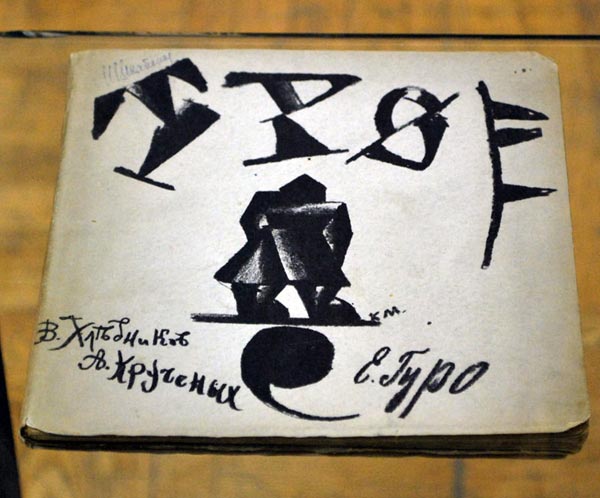 Velimir Khlebnikov, Velimir Khlebnikov, Alexei Kruchenykh, Elena Guro. Three | Tango with Cows. 1914 |
attempt to draw public attention to its publication, the Futurists, in some cases have paint their books by hand in watercolor, and Olga Rozanova first painted not only the illustrative material, but just text pages, giving them, as can be seen at the show, an amazing design look. Other achievements include the Russian Futurists and, we believe, the world's first work with accented fonts. Officially the world's first book with the accented characters is the book Tommaso Marinetti's "Zang Pedestals Pedestals", published in 1914 in Milan, but in 1913 in a futuristic book "Donkey's Tail and Target", in the article S. Khudyakov, on page 145 were shows a futuristic poem, printed not only with the use of accent font, but also arbitrary - in different directions - arrangement of words. It should also mention the two books Vasily Kamensky - "Naked among dressed" and "Tango with Cows," which appeared in 1914 and far ahead of the later editions of foreign "Dada", also used the typographical experiments Kamensky in his famous journals. It is pertinent to mention the famous "Poem of the End" cubo-futurist Basilisk Gnedova, published in the book "Death of Art" in 1913 and was incorporated into all the world's avant-garde research. He first published it as a clean sheet, leaving him only the title, and he read this poem is not opening his mouth, making it clear he only hand movements.
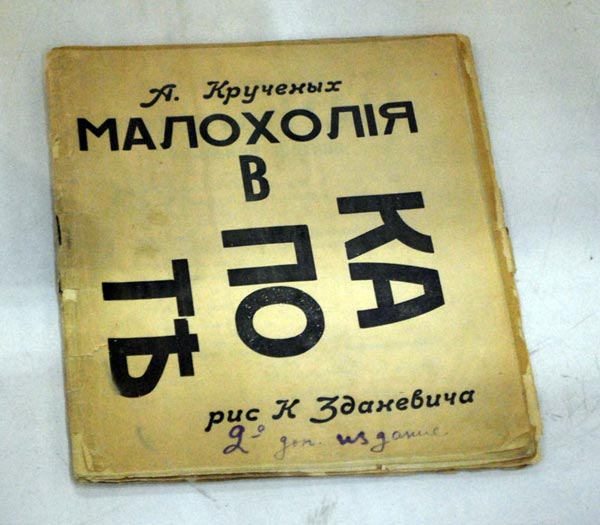 Alexei Kruchenykh Alexei Kruchenykh Maloholiya in the hood. | Tsotsa |
Russian Futurism developed rapidly thanks to the books, the texts which write Kruchenykh, Khlebnikov, V. Kamensky, I. Zdanevich , AI Terent'ev, Mayakovsky and other poets. In the early period to the Futurists were self and poets such as symbolist Igor Severyanin and even Boris Pasternak. Active participation in Futurism took and wealthy financial Burliuks brothers, who wrote not only poetry, but also engaged in painting. David Burliuk even got later the title "father of Russian Futurism." It should be noted and creative contribution to the development of futuristic shot in 1938 by Konstantin Bolshakov, issuing in 1913 a collection of poems with the laconic title Le futur. Lithographed book was illustrated by the works of Larionov and Goncharova, and owing Larionov lithographs depicting prostitutes labeled "B. and 3 rubles. "was almost completely destroyed by censorship and kept copies in a matter.
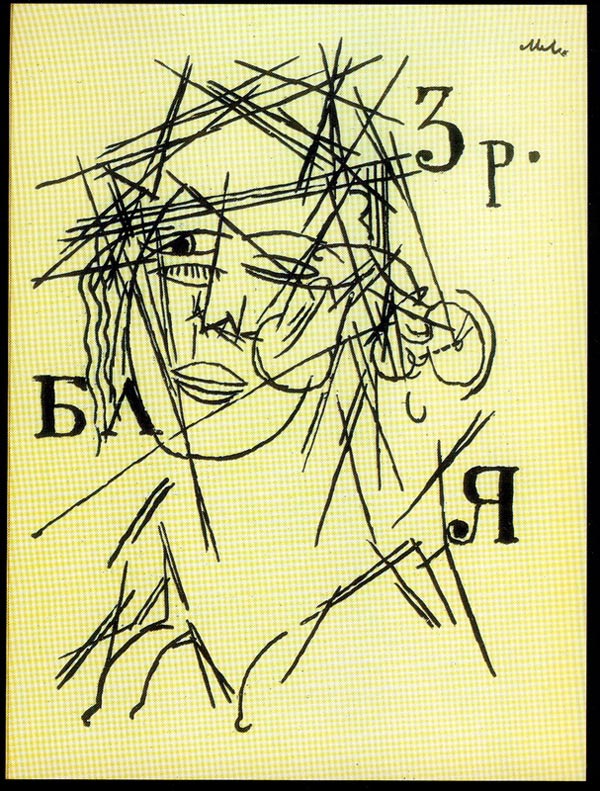 Lithography Mikhail Larionov in the book Le futur Lithography Mikhail Larionov in the book Le futur |
With book editions and scandals in the public speeches movement Futurists became widely circulated throughout Russia. Futurism emerged centers in St. Petersburg, Tbilisi, Kazan, Odessa, and eventually got to the fascination with futurism of Siberia and the Far East, where they began to publish collections of local futurist poets and take their statements. The most active up until 1921 developed community of futurists and others who joined them artistic groups in the Caucasus, particularly in Tbilisi and Baku. Development of these groups contributed to the emergence in the Transcaucasus Alexei twisted, left Moscow at the time of the First World War, as well as the activities of the brothers Zdanevich - Cyril , a kind of artist-futurist, and Elias, poet and designer-printers, who founded the avant-garde group "41 degrees". This group name must, according to various sources, or geographic location of Tiflis on 41 degrees of latitude, or the percentage of alcohol in all the favorite Russian drink. It is in the Caucasus, Alexei twisted and the company managed to create a gallery hectographed books with an arbitrary arrangement of words on the plane. Hectographed called books printed by hand at home, with a circulation of 10.6 copies. These books scholar Russian avant-garde Rosemarie Ziegler called Suprematism in poetry. One of these publications Twisted - "Nosoboyka" - included in the exhibit.
twisted off to the Caucasus, Burliuk immediately after the Bolshevik Revolution of 1917 went to the Far East, and then permanently for abroad, thus main representatives of the Russian avant-garde in Moscow began to Vladimir Mayakovsky and his co-author of several publications Nicholas Aseev, to unconditionally accept the revolution and the power of the Bolsheviks. There are even reports that Anatoly Lunacharsky, who became one of the leaders of the Bolsheviks, and responsible for culture, introduced Mayakovsky with a list of poets and writers, in which Mayakovsky said loyal to the revolution, as well as those who, in his opinion, the revolution did not take which, of course, subsequently influenced their fate.
linked his work with the futurist poet artists also began to create paintings in the style of Futurism. One of these works, shown at the exhibition can be considered a small oil paintings, where Mikhail Larionov on one canvas, depicted as four seasons: from the bright spring through summer and autumn trees, a rainbow, to a snowy winter road, harmoniously combining them together. Even the poets began to carry out painting works. In particular, artists began to write poems, David Burliuk and Vasily Kamensky, and began to write poems wonderful artist Olga Rozanova, in love with the poet Alexei twisted.
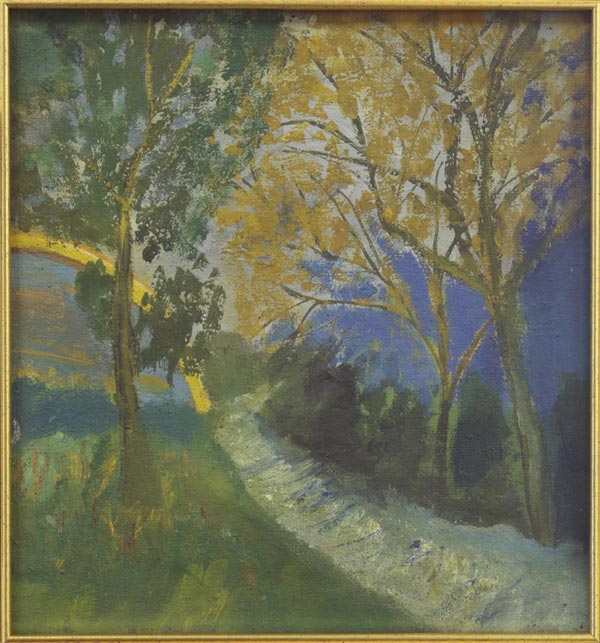 Mikhail Larionov Mikhail Larionov |
Suprematism
Development Futurism and enthusiasm of young artists led to the creation of a new, so-called "non-objective" art movement called, with a light hand by Kazimir Malevich, Suprematism. Until late 1915, Russian artists who hold views on the avant-garde painting and actively take futurism, creating their own work, based on the work of the representatives of the Western avant-garde trends. Among them we mention the Italian futurist Gino Severini (Gino Severini), Carlo Carrà (Carlo Carrà), Fortunato Depero (Fortunato Depero), Giacomo Balla (Giacomo Balla), and actively promoting the French cubism of Pablo Picasso (Pablo Picasso) and Georges Braque (Georges Braque) .
At the end of December 1915 Malevich, who previously worked in the style of Cubism, in "The Last Futurist Exhibition of paintings 0.10, which was attended by most advanced artists, all of a sudden put 49 "Supremacist" paintings by issuing them a showroom. Moreover, he released a small program booklet entitled "From Cubism to Suprematism. New pictorial realism, "explains artistic conception of Suprematism. This brochure Malevich distributed during the exhibition, and unsold copies, making them a new cover with the words "Second Edition", has issued since the date "1916", thereby implying that, say, the first edition in demand and instantly dispersed . The third edition (actually second) is dated 1916, too, it is a smaller format, revised and supplemented by the author and is called "From Cubism and Futurism to Suprematism." Cover of this edition is decorated with a black square, which became an icon of Suprematism, and the text placed two suprematic illustrations.
Malevich is considered the founder of Suprematism. But in the same 1916 in the preface to the album of collages "Universal War Z. Colored glue ", issued together with Olga Rozanova, Alexei twisted states:" abstruse painting becomes dominant. Previously, Olga Rozanova gave samples, it is now developing several artists, including Malevich, Puni and others, giving her malogovoryaschee title: Suprematism. " Twisted this statement, one of the pillars of the Russian avant-garde in 1913, placing the lithography Malevich in his book editions, in fact, claims priority Olga Rozanova in creating non-objective painting, called Malevich Suprematism. Now, many Western critics also believe Olga Rozanova principal in the creation and development of Russian non-objective painting.
Unlike Futurism which has received fairly widespread among the many artists and poets, Suprematism interested much less creative people . The main adherents of Suprematism, in addition to Malevich became N. Suetin , I. Chashniki , L. and a small number of other artists, who influenced him in a short period of Suprematism. However, the main followers of Suprematism were members of the Vitebsk group, who took for himself sounding name UNOVIS (affirmative new art), headed UNOVIS Kazimir Malevich. That representatives UNOVIS in 1919 for the first time tried to bring Suprematism in the streets: the various revolutionary events of Vitebsk they decorated for his work, making out the traditional signs and slogans in the style of Suprematism. One of these works, the sign "Dining Room", you can see in our exhibit. Only later, in mid-1920's, leadership in the decoration of city streets will take the constructivist, his work filled the big cities to massive parties and events. The tradition of decorating the town for the holidays and preserved to our days, but now those jewels are increasingly using the elements of advertising.
 sign "Canteen." Vitebsk sign "Canteen." Vitebsk |
In addition to painting, the most widely used Suprematism was in the design of Soviet porcelain in 1920 -30-ies at the State Porcelain Factory, partly Dulevo factory and trust "Novgubfarfor. After the early death (in 1929) is perhaps the best among collectors of porcelain-Suprematists, Ilya Chashniki, Supremacist painted porcelain lasted until mid-1930's. Basically, she graced the export of work that are popular overseas, and the works of N. Suetina (since 1932 the chief artist GFZ), including porcelain vases Suprematist, called "suetony, for the appearance of which were close and the Architect of Malevich.
| | 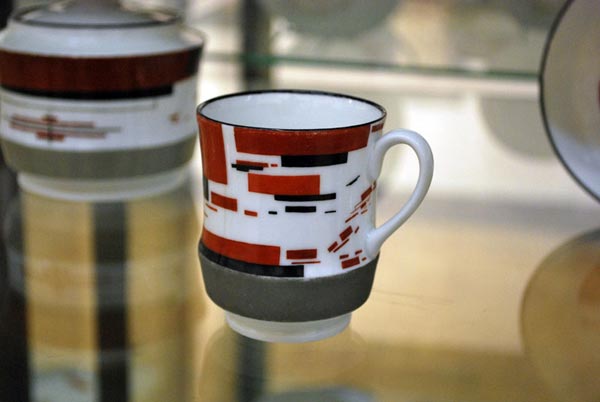 Suprematic china Suprematic china |
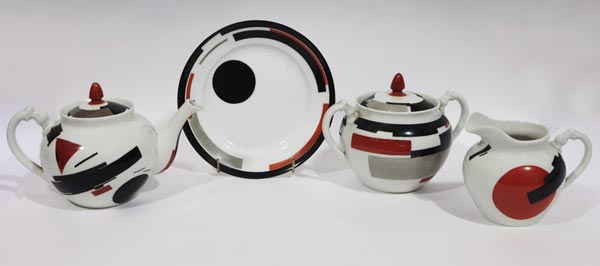 Nicholas Suetin. Service Nicholas Suetin. Service | |
Even the coffin, which in 1935 was buried Malevich himself was made on the sketches Suetina and had a form of Suprematist Architect. Suetin owned and rare building projects Suprematist furniture (1920), both practically and not implemented during the life of the author. In our exhibition you can see suprematic table and two chairs for him, made from drawings Nicholas Suetina.
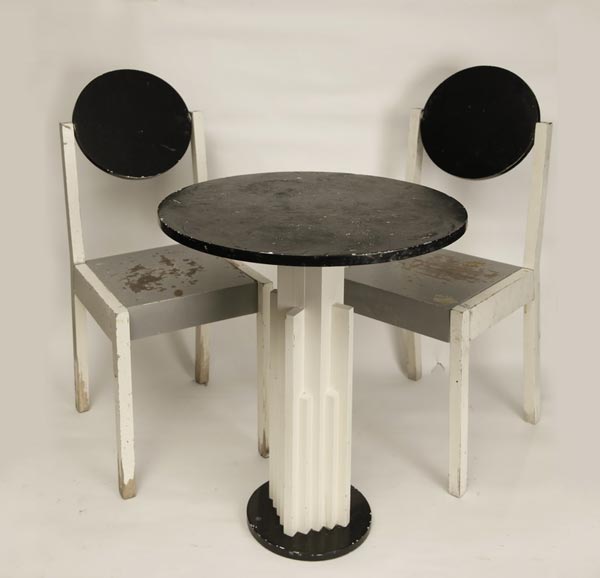 Suprematic table and two chairs. Suprematic table and two chairs. The drawings Nicholas Suetina |
If Futurism gave the world the entire deposit Futurist publications, in the style of Suprematism has been issued no more than fifteen books. One of the most prominent publications was the book AN Puni "The first series of lectures readable short courses for teachers of drawing, published in 1920 in Petrograd, and decorated with colored covers of Malevich.
Yet Despite the small number of enthusiastic sponsors, Suprematism was able to survive for almost twenty years until the death of Malevich by side with a rapidly developing and have become fashionable in the 1920's constructivism.
Constructivism
After the Revolution of 1917 by Vladimir Mayakovsky Futurism, which became a "mouthpiece" of the revolution, stepped into the 1920's, which gradually degenerated into a new avant-garde movement - constructivism.
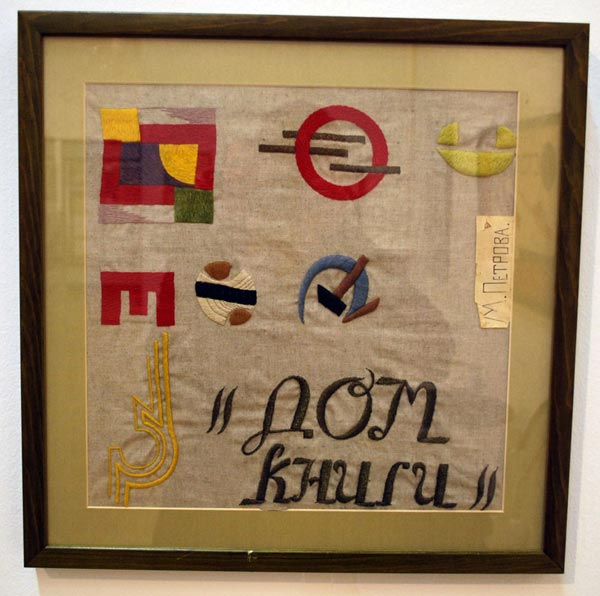 M. PETROVA M. PETROVA Embroidery "House of Books." End of 1920 |
Constructivism was imposed on the general population of Russia and was adopted them, as the constructivists in all areas of art sought to oppose the ostentation of life simple and emphasize the usefulness of new forms. In this they have seen democracy in the relations between people of the new Bolshevik and later Soviet Russia. The term "constructivism" has been used by artists and architects in 1920, but officially it was first marked by Alexei Gan, in his book "Constructivism", which appeared only in 1922. In it the author emphasized that the culture of the new Russia is an industrial, and set the main objective of the Constructivists' communist expression of material values. " On a wave of constructivism appears many periodicals promoting this trend in art - in particular, journals LEF (Left Front of Art ") and Novy LEF, go under the editorship of Vladimir Mayakovsky, and several other journals:" CA "( "Modern Architecture"), "The team of artists," "Give" and some others. Constructivism is actively promoted not only in the two capitals but also in other regions of Russia: for example, avant-garde constructivist become Ukrainian periodicals "YUGOLEF" and "New Generation" and others, some of them by design at times greater than central publications by young artists who worked on their design.
most widespread constructivism gets in the architecture, as well as in printing. Architectural masterpieces created Konstantin Melnikov, the brothers Vesnins (Leonid, Viktor and Alexander ), N. Ladovsky, V. Shukhov, J. Chernikhov and many other young architects. Some of their projects failed to materialize, and they are preserved to this day. In Printing glisten Russian designers who have received international recognition, such as , Stepanova , S. Telingater , A. Gan, L. ,
Permanent link to:
https://artinvestment.ru/en/invest/events/20110314__borovikov.html
https://artinvestment.ru/invest/events/20110314__borovikov.html
© artinvestment.ru, 2025
Attention! All materials of the site and database of auction results ARTinvestment.RU, including illustrated reference information about the works sold at auctions, are intended for use exclusively for informational, scientific, educational and cultural purposes in accordance with Art. 1274 of the Civil Code. Use for commercial purposes or in violation of the rules established by the Civil Code of the Russian Federation is not allowed. ARTinvestment.RU is not responsible for the content of materials submitted by third parties. In case of violation of the rights of third parties, the site administration reserves the right to remove them from the site and from the database on the basis of an application from an authorized body.


